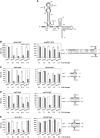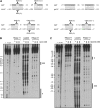Multiple factors dictate target selection by Hfq-binding small RNAs
- PMID: 22388518
- PMCID: PMC3343335
- DOI: 10.1038/emboj.2012.52
Multiple factors dictate target selection by Hfq-binding small RNAs
Abstract
Hfq-binding small RNAs (sRNAs) in bacteria modulate the stability and translational efficiency of target mRNAs through limited base-pairing interactions. While these sRNAs are known to regulate numerous mRNAs as part of stress responses, what distinguishes targets and non-targets among the mRNAs predicted to base pair with Hfq-binding sRNAs is poorly understood. Using the Hfq-binding sRNA Spot 42 of Escherichia coli as a model, we found that predictions using only the three unstructured regions of Spot 42 substantially improved the identification of previously known and novel Spot 42 targets. Furthermore, increasing the extent of base-pairing in single or multiple base-pairing regions improved the strength of regulation, but only for the unstructured regions of Spot 42. We also found that non-targets predicted to base pair with Spot 42 lacked an Hfq-binding site, folded into a secondary structure that occluded the Spot 42 targeting site, or had overlapping Hfq-binding and targeting sites. By modifying these features, we could impart Spot 42 regulation on non-target mRNAs. Our results thus provide valuable insights into the requirements for target selection by sRNAs.
Conflict of interest statement
The authors declare that they have no conflict of interest.
Figures






Similar articles
-
Acidic Residues in the Hfq Chaperone Increase the Selectivity of sRNA Binding and Annealing.J Mol Biol. 2015 Nov 6;427(22):3491-3500. doi: 10.1016/j.jmb.2015.07.010. Epub 2015 Jul 18. J Mol Biol. 2015. PMID: 26196441 Free PMC article.
-
Alternative Hfq-sRNA interaction modes dictate alternative mRNA recognition.EMBO J. 2015 Oct 14;34(20):2557-73. doi: 10.15252/embj.201591569. Epub 2015 Sep 15. EMBO J. 2015. PMID: 26373314 Free PMC article.
-
Hierarchy in Hfq Chaperon Occupancy of Small RNA Targets Plays a Major Role in Their Regulation.Cell Rep. 2020 Mar 3;30(9):3127-3138.e6. doi: 10.1016/j.celrep.2020.02.016. Cell Rep. 2020. PMID: 32130912 Free PMC article.
-
New molecular interactions broaden the functions of the RNA chaperone Hfq.Curr Genet. 2019 Dec;65(6):1313-1319. doi: 10.1007/s00294-019-00990-y. Epub 2019 May 18. Curr Genet. 2019. PMID: 31104083 Review.
-
Target activation by regulatory RNAs in bacteria.FEMS Microbiol Rev. 2015 May;39(3):362-78. doi: 10.1093/femsre/fuv016. Epub 2015 Apr 30. FEMS Microbiol Rev. 2015. PMID: 25934124 Free PMC article. Review.
Cited by
-
Gene knockdown by structure defined single-stem loop small non-coding RNAs with programmable regulatory activities.Synth Syst Biotechnol. 2022 Nov 30;8(1):86-96. doi: 10.1016/j.synbio.2022.11.006. eCollection 2023 Mar. Synth Syst Biotechnol. 2022. PMID: 36582457 Free PMC article.
-
Comparative genomics boosts target prediction for bacterial small RNAs.Proc Natl Acad Sci U S A. 2013 Sep 10;110(37):E3487-96. doi: 10.1073/pnas.1303248110. Epub 2013 Aug 26. Proc Natl Acad Sci U S A. 2013. PMID: 23980183 Free PMC article.
-
CRP-cAMP mediates silencing of Salmonella virulence at the post-transcriptional level.PLoS Genet. 2018 Jun 7;14(6):e1007401. doi: 10.1371/journal.pgen.1007401. eCollection 2018 Jun. PLoS Genet. 2018. PMID: 29879120 Free PMC article.
-
CsrA Shows Selective Regulation of sRNA-mRNA Networks.bioRxiv [Preprint]. 2023 Mar 29:2023.03.29.534774. doi: 10.1101/2023.03.29.534774. bioRxiv. 2023. PMID: 37034808 Free PMC article. Preprint.
-
Spot 42 sRNA regulates arabinose-inducible araBAD promoter activity by repressing synthesis of the high-affinity low-capacity arabinose transporter.J Bacteriol. 2017 Feb;199(3):e00691-16. doi: 10.1128/JB.00691-16. Epub 2016 Nov 14. J Bacteriol. 2017. PMID: 27849174 Free PMC article.
References
-
- Bouvier M, Sharma CM, Mika F, Nierhaus KH, Vogel J (2008) Small RNA binding to 5′ mRNA coding region inhibits translational initiation. Mol Cell 32: 827–837 - PubMed
-
- Buchet A, Nasser W, Eichler K, Mandrand-Berthelot MA (1999) Positive co-regulation of the Escherichia coli carnitine pathway cai and fix operons by CRP and the CaiF activator. Mol Microbiol 34: 562–575 - PubMed
Publication types
MeSH terms
Substances
Grants and funding
LinkOut - more resources
Full Text Sources
Other Literature Sources
Molecular Biology Databases

